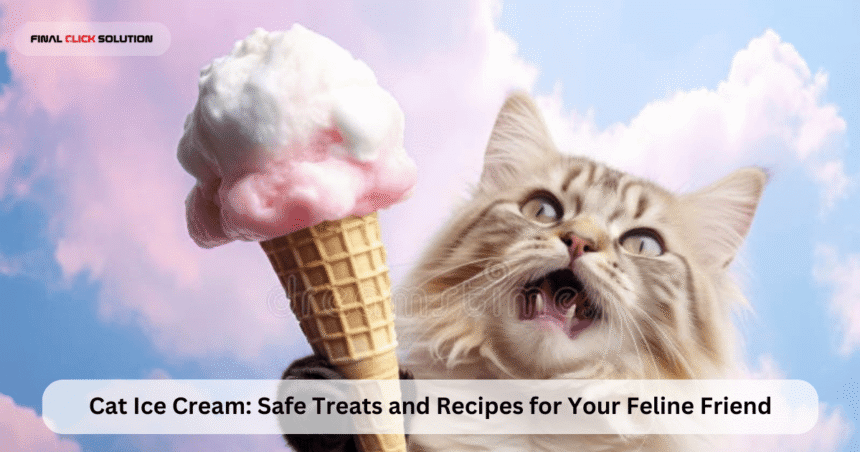In the world of pet treats, few things spark as much curiosity as cat ice cream. This frozen delight, tailored specifically for felines, has gained popularity among cat owners looking for fun ways to spoil their pets. But what exactly is cat ice cream, and is it something you should introduce to your kitty’s diet? In this comprehensive guide, we’ll dive deep into the topic, exploring the safety, benefits, recipes, and more surrounding cat ice cream. Whether you’re a seasoned cat parent or a new adopter, understanding cat ice cream can help you make informed decisions about your pet’s snacks.
The Appeal of Cat Ice Cream
Cat ice cream isn’t just a gimmick; it’s a creative solution to a common pet owner dilemma. Many of us enjoy sharing our favorite foods with our pets, but human treats like traditional ice cream often pose risks to cats. That’s where cat ice cream comes in – a specially formulated version that’s safe and enjoyable for felines. The concept of cat ice cream has evolved from homemade experiments to commercial products available in pet stores worldwide.
One of the primary reasons cat ice cream has become so popular is its ability to provide a cooling treat during hot summer days. Cats, like humans, can appreciate a refreshing snack when temperatures rise. However, it’s essential to distinguish between regular dairy-based ice cream and versions designed for cats. Cat ice cream typically avoids ingredients that could harm your pet’s digestive system, making it a thoughtful alternative.
Addressing Common Questions About Cats and Ice Cream
When it comes to feline nutrition, questions about treats are abundant. For instance, can cats eat ice cream? This is a frequent query among pet owners who catch their cats eyeing a bowl of vanilla swirl. The short answer is that while a tiny lick might not cause immediate harm, regular ice cream isn’t recommended for cats due to several health concerns.
Similarly, can cats have ice cream as part of their routine? Experts generally advise against it because most cats are lactose intolerant after weaning. Lactose, the sugar found in milk, can lead to digestive upset, including diarrhea, vomiting, and bloating. If you’re wondering about an ice cream cat – perhaps envisioning a whimsical feline-themed dessert – it’s more about adapting the idea to suit cats’ needs rather than letting them indulge in human versions.
Another variation of this concern is whether a cat can eat ice cream without repercussions. In small amounts, some cats might tolerate it, but it’s not worth the risk. Factors like the cat’s age, health status, and individual tolerance play a role. Puppies – wait, kittens – are particularly sensitive, and older cats with pre-existing conditions should avoid it altogether.
For those seeking safer options, ice cream for cats is readily available or easy to make at home. These products or recipes use lactose-free ingredients, ensuring your cat can enjoy a frozen treat without the tummy troubles.
Why Regular Ice Cream Isn’t Suitable for Cats
To understand the need for specialized cat ice cream, let’s break down why traditional ice cream can be problematic. Most ice creams are made from cow’s milk, which contains lactose. Kittens produce the enzyme lactase to digest their mother’s milk, but as they mature into adult cats, lactase production decreases significantly. This lactose intolerance affects up to 90% of adult cats, leading to uncomfortable symptoms when they consume dairy products.
Beyond lactose, ice cream is loaded with sugar, which cats don’t process well. Felines are obligate carnivores, meaning their bodies are designed for a high-protein, low-carbohydrate diet. Excessive sugar can contribute to weight gain, diabetes, and dental issues. Artificial sweeteners like xylitol, sometimes found in sugar-free varieties, are toxic to cats and can cause severe hypoglycemia or liver failure.
Fat content is another issue. While cats need fats in their diet, the high levels in creamy ice cream can lead to pancreatitis or obesity if overfed. Chocolate-flavored ice creams are especially dangerous due to theobromine, a compound toxic to cats that can cause heart problems, seizures, and even death. Nuts, raisins, or other add-ins common in human ice cream can also be choking hazards or contain toxins.
Veterinarians often recommend steering clear of sharing your dessert bowl. Instead, opt for cat ice cream alternatives that mimic the texture and fun without the risks. By choosing cat-specific treats, you’re prioritizing your pet’s health while still providing enjoyment.
The Rise of Commercial Cat Ice Cream Products
The pet industry has responded to the demand for safe treats with a variety of commercial cat ice cream options. Brands like Ben & Jerry’s have even ventured into the pet space with dog-focused products, but cat versions are catching up. Look for products labeled as “cat ice cream” or “feline frozen treats” in pet supply stores or online.
These commercial offerings often use goat’s milk or lactose-free milk as a base, combined with cat-friendly flavors like tuna, chicken, or salmon. Some are fortified with vitamins, probiotics, or taurine – an essential amino acid for cats. Taurine deficiency can lead to heart and eye problems, so including it in treats is a bonus.
When selecting cat ice cream, read labels carefully. Avoid those with added sugars, artificial colors, or preservatives. Organic or natural options are ideal. Portion control is key; even safe cat ice cream should be an occasional treat, not a daily staple. Aim for no more than 10% of your cat’s daily calories from treats to maintain a balanced diet.
Homemade Cat Ice Cream Recipes: Simple and Nutritious
If you prefer a DIY approach, making cat ice cream at home is straightforward and allows customization. Start with basic ingredients that are safe and appealing to cats. Here’s a simple recipe for beginner cat owners:
Basic Tuna Cat Ice Cream
Ingredients:
- 1 can of tuna in water (low-sodium, no additives)
- 1/2 cup plain, lactose-free yogurt or goat’s milk
- 1/4 cup water or low-sodium chicken broth
- Optional: A sprinkle of catnip for extra fun
Instructions:
- Drain the tuna and mash it into a fine consistency.
- Mix in the yogurt or milk and water until smooth.
- Pour into ice cube trays or silicone molds.
- Freeze for 2-3 hours until solid.
- Serve one cube at a time, letting it thaw slightly for easier eating.
This recipe yields about 8-10 servings and is a hit with most cats. The tuna provides protein, while the dairy alternative ensures digestibility.
For a more adventurous twist, try Chicken and Pumpkin Cat Ice Cream:
Ingredients:
- 1/2 cup cooked, shredded chicken (plain, no seasoning)
- 1/4 cup pure pumpkin puree (not pie filling)
- 1/2 cup lactose-free milk
- A dash of cinnamon (optional, in tiny amounts)
Blend everything, freeze in molds, and watch your cat enjoy. Pumpkin aids digestion and is low in calories, making it perfect for weight-conscious kitties.
Salmon Delight Cat Ice Cream:
- 1/2 cup canned salmon (boneless, skinless)
- 1/3 cup coconut milk (unsweetened)
- 1/4 cup water
Puree, freeze, and serve. Salmon offers omega-3 fatty acids for healthy skin and coat.
Always introduce new treats gradually to monitor for allergies. Consult your vet if your cat has dietary restrictions.
Health Benefits of Cat Ice Cream
Beyond being a fun indulgence, cat ice cream can offer nutritional perks when made thoughtfully. Protein-rich versions support muscle maintenance, especially for active or senior cats. Hydration is another benefit; frozen treats encourage water intake, crucial for cats prone to urinary issues.
Probiotic-enriched cat ice cream can promote gut health, aiding in digestion and immune function. Ingredients like pumpkin provide fiber to prevent constipation, a common feline ailment. Omega-3s from fish-based recipes contribute to joint health and reduce inflammation.
Mentally, cat ice cream stimulates your pet. The act of licking a frozen treat provides enrichment, reducing boredom and stress. It’s particularly useful for indoor cats needing mental stimulation.
Potential Drawbacks and Precautions
While cat ice cream is generally safe, moderation is essential. Overfeeding can lead to calorie overload and weight gain. Monitor portion sizes based on your cat’s size and activity level – a teaspoon or two is often sufficient.
Watch for signs of intolerance, such as excessive gas or lethargy. If your cat has diabetes, kidney disease, or allergies, skip dairy alternatives altogether and consult a vet.
Storage matters too; homemade cat ice cream lasts about a week in the freezer. Thaw only what you’ll use to avoid bacterial growth.
Integrating Cat Ice Cream into Your Pet’s Lifestyle
Incorporating cat ice cream into your routine can strengthen the bond with your pet. Use it as a reward during training or a special treat on birthdays. Pair it with playtime for a holistic experience.
For multi-cat households, ensure each cat gets their share to prevent jealousy. Kittens under six months should stick to kitten formula-based treats.
Expert Opinions and Studies on Feline Treats
Veterinary nutritionists emphasize balanced diets over treats. According to the American Veterinary Medical Association, treats should complement, not replace, meals. Studies in the Journal of Feline Medicine and Surgery highlight lactose intolerance’s prevalence, reinforcing the need for alternatives like cat ice cream.
Pet behaviorists note that food puzzles involving frozen treats can curb destructive behaviors. A study from the University of Guelph found enriched environments, including novel foods, improve cat welfare.
Conclusion: Treat Your Cat Wisely
Cat ice cream represents a delightful intersection of fun and nutrition for felines. By choosing or making safe versions, you can indulge your cat without compromising health. Remember, the key is variety and moderation. Whether opting for commercial products or homemade recipes, cat ice cream can be a pawsitive addition to your pet’s life.
Always prioritize your cat’s well-being and consult professionals for personalized advice. With the right approach, cat ice cream can become a cherished part of your feline friendship.








